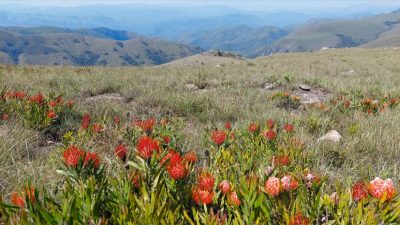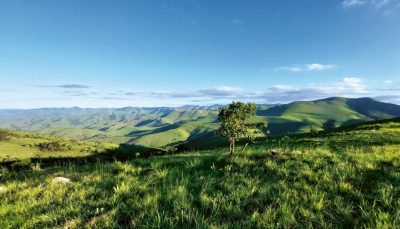Growing up on a smallholding with parents who loved to grow veggies and potter around the garden rubbed off on young Delia, who found she had quite an affinity with green and growing things. However, it was after a visit from the Mpumalanga Plant Specialist Group to the Mountainlands Nature Reserve in the Barberton region that she truly learnt about the uniqueness of the plants on the reserve. “I started to build up a representative herbarium collection of the plants growing on Mountainlands and the Barberton Centre of Plant Endemism,” she says. “In simple terms, a herbarium is a library of dried pressed plants mounted on paper with accompanying data. I do the expansion, physical and scientific curation of the collection. It has been a steep learning curve for someone who does not have an academic background in botany! I have acquired an arsenal of study material and have bugged everyone I know to help with identifications and practical advice,” she smiles.

From 2017 to 2021, Delia was an honorary research associate at the School of Animal, Plant and Environmental Sciences at the University of the Witwatersrand, where she collaborated on projects that included the description of the plants she had collected. “The taxonomy side continues as we are working on several plants new to science,” she says, “and being able to work in the Barberton area is a great privilege. There are so many places on Mountainlands to explore and several plants new to science that need to be described. Luckily, over time, the species become familiar and novelties are easier to recognise. I love macrophotography and the detail it brings to the fore, especially when plants and flowers are tiny.”


Delia’s regional botanical knowledge also serves other botanists who work on specific plant groups, as well as researchers and students in other fields such as ecology and zoology. She also contributes to the management, communication and marketing activities of the Mountainlands Nature Reserve, Barberton Makhonjwa World Heritage Site and the region in general, with an emphasis on plant diversity. Delia’s passion for Mountainlands is evident in every word as she describes what she calls a ‘veritable Eden’. An idyllic 18 000-hectare proclaimed nature reserve in the mountains near Barberton, Mountainlands is also part of the Barberton Makhonjwa World Heritage Site. World Heritage Site status is the highest form of protection possible, and is well deserved for Mountainlands due to its unique natural attributes, all the way from the geology to the plants.
The 18 000ha that comprises Mountainlands was first reserved for conservation in 1985. “My husband has always been a visionary man,” smiles Delia, “and when our family bought farms in the Barberton area, he looked at the neighbouring properties and realised their conservation value. Lengthy consultations under the marula tree with other stakeholders, among them officials of the then Mpumalanga Parks Board and representatives of the Lomshiyo Community Trust, took place to get the reserve off the ground. The state, community-owned and privately held land was consolidated into the reserve when the perimeter game fence was erected in 2000 and game such as zebra, eland, blue wildebeest and others were reintroduced. The model holds all the elements of a true community-public-private sector partnership, and on this large scale, it was a pioneering concept for conservation in South Africa.”

Falling within the Barberton Greenstone Belt, Mountainlands is known for its ancient geology that dates back nearly 3.6 billion years. The geology is packed with information about the early Earth and its formation. Delia explains that because the Barberton geology is so unique, it allows for many plants to speciate.
“This is why we have plants that only occur there and nowhere else in the world. The high levels of endemism are found in the grasslands and not necessarily in forests,” she says. “What is exciting about plants is that there is always something new to discover and learn. When botanists visit, I am fascinated by what they are interested in as it is an opportunity to learn and look at the plants through their eyes. I have a soft spot for the family Apocynaceae (milkweeds), as most of them have very showy flowers and are very photogenic. From a research perspective, my current interest lies in the Moraea and Colchicum species of Mpumalanga.”
The lowest point on Mountainlands is 540m above sea level, and the highest 1 640m. An interplay of factors such as the range in elevation, unique geographical location, climate and broken mountain topography, abundance of pollution-free streams and different rainfall levels have endowed it with a remarkable and diverse flora. It is also one of the most important refuges in the province for plant species threatened by climate change.
“The importance of preserving this heritage is crucial, and it is extremely important to be aware of the natural world. The future of all life on Earth depends on us, and that is a great responsibility,” says Delia. “We are part of this vast, intelligent, interconnectedness that supplies us with all the food, medicine, clean drinking water, minerals and other natural resources we need. The more time people spend in the natural world, the more time they have to bond with it and realise the benefits it has on physical, mental and emotional levels and how it supports all life on Earth. Forget about the phone or computer and go outside,” Delia advises. “And don’t throw your rubbish out of your car window or leave it where you have stopped next to the road. Educate yourself so that you can serve the natural world with purpose. When you read about the history of Mpumalanga and how it was teeming with wildlife trekking through the area, grazing vast grasslands, and you compare it to what you see now, then you realise our modern ways have had a great negative impact on the natural world.”

Some of our endemic plants occur in very small areas, and if that is disturbed, it can mean the tipping point for a species, and when that species is extinct in the wild, it is like breaking a link in a chain, affecting many other species. Who knows what cures for human diseases those plants may hold? If we don’t protect them, we will never know.
In December 2023, Delia had the great honour of having a succulent from the Barberton Centre of Plant Endemism named after her by Prof Gideon Smith, who wrote, among other things, “This is recognition for your selfless and and extensive contributions to our knowledge of the vegetation of our beautiful country.” A fitting message to someone who values the importance of the fauna and flora we are privileged enough to have.


